#cwiar
Note
PLEASE TELL US ABOUT Y DDRAIG TRAWS!
Certainly! I'm more than happy to oblige.
First though I'm gonna need to tldr: the history of Y Ddraig Goch before we get onto the (accidentally) canonically trans part.
A brief history of Y Ddraig Goch:
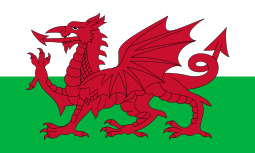
(The modern Welsh flag)
Y Ddraig Goch first appears in the tales of the Mabinogi (Charlotte Guest version) in the tale of Lludd and Llefelys where it is fighting a white dragon. The fight is also described/expanded upon in the c. 829 AD text Historia Brittonum (attributed to Nennius) - where the red dragon represents Wales and the white dragon represents the Anglo-Saxons. In the story the red dragon triumphs over the white. Of course, Geoffrey of Monmouth also covers the story c. 1136 in Historia Regnum Brittaniae in which he introduces the concept of the red dragon heralding the arrival of King Arthur.
Geoffrey of Monmouth claims Arthur used a banner featuring a golden dragon. But we also know the accuracy of Monmouth can be questionable at times. Owain Glyndŵr did use a banner with a golden dragon called Y Ddraig Aur - raised in 1401 at Caernarfon - Glyndŵr chose this banner as a nod to the supposed banner of Arthur and his father.
Later on the Tudor monarchs (being a Welsh family) adopted a red dragon on a white and green background in their heraldry. Eventually Y Ddraig Goch on a white and green background became the official badge of Wales in 1800. The design became the official flag of Wales in 1959.
Y Ddraig Traws:
Now for the thing you're all here for -
So, as outlined, the history of the dragon as a national symbol of Wales goes back a long way. If we're just talking post-1959, there's some interesting implications for Y Ddraig Goch's depiction.
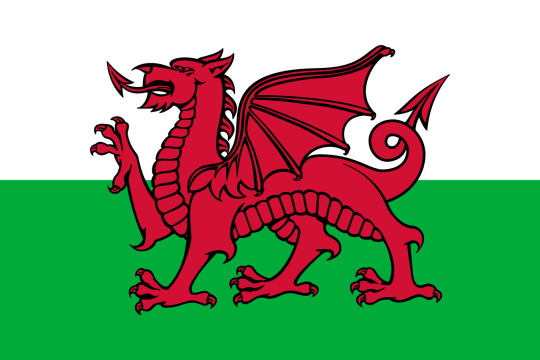
This is what the Welsh flag (and Y Ddraig Goch) looked like in 1959 when it was officially adopted as the flag of Wales. It looks broadly the same as the first flag and has some common features - such as not having a penis (or, as in the correct heraldic terminology - a pizzle). Meanwhile, in the arms of the Tudors (specifically Henry VII)
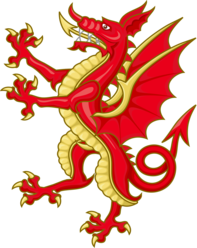
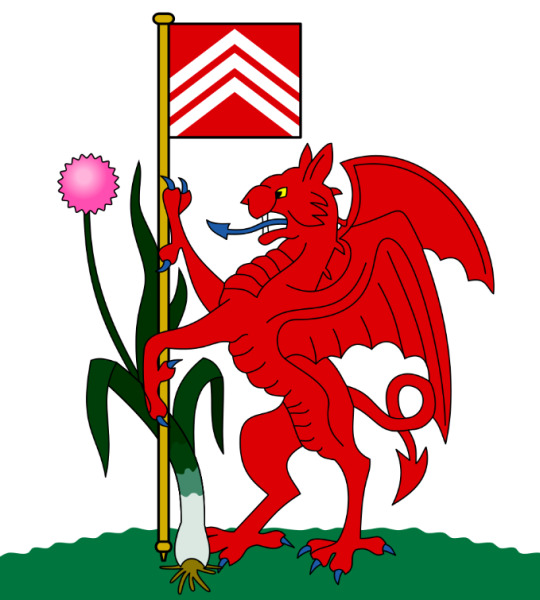
(Tudor dragon with pizzle) vs (dragon on the flag of Cardiff - pizzleless)
the penis is almost always included. So much to the point that the present royal family still includes the penis. While pretty much 0 depictions of the dragon in Wales include a penis. So you could interpret this as the dragon is seen as male only by the British royal family and as female everywhere else (which kinda implies that at some point the Tudor dragon had an mtf transition in Wales and she keeps getting misgendered by the royal family every time she is depicted in (mostly) England).
So much to the point that in 1995 this pound coin was made by the Royal Mint featuring the pizzle on the dragon with all four feet touching the ground as opposed to standing up (passant rather than rampant).

But in Wales you'd be hard pressed to see a pizzled dragon anywhere. Ergo, we can only conclude Y Ddraig Goch is trans and she transitioned in Wales and keeps getting misgendered in England.
[note: This is mostly tongue in cheek - but I do think it's fun to extrapolate that the Welsh dragon is trans because of the differences in depiction between Wales and England. Like many things Welsh, it is misrepresented by England and the idea of the Welsh dragon being misgendered only in England is, I think, a good metaphor for a whole lot of English treatment of Wales.]
Unrelatedly, there is a gay Welsh flag held at the National Museum of Wales which has a very wonky dragon which I find very endearing.

(cleaned up version I made)
So much so I made it an emoji in my Welsh bilingual LGBTQIA+ Discord (requirements for joining are - be 16+, either speak or are learning Welsh and identify as LGBTQIA+ in some way. Dm for link!).

(triaist ti 'you tried' emoji)
~ Completely unrelatedly ~ never forget the time someone was trying to homophobic to me by suggesting that I was disrespecting all the soldiers who died 'for the Welsh flag' by making it rainbow colours and not red - arguing that any change of colour of the dragon was disrespectful. Reader, my bus pass at the time for Mid Wales Travel had a purple dragon on it.
#cymraeg#welsh#cymblr#cwiar#trawsryweddol#traws#trans#trans dragon#y ddraig goch#welsh dragon#welsh history#dragons#wyverns#last tag because technically Owain's golden dragon is technically a wyvern
490 notes
·
View notes
Text
This is very silly, but,
The Welsh word for queer and for chicken are spelled so similar I can't help but find it funny
Queer: cwiar (quee-ar)
Chicken: cw iâr (queue yar)
I don't have enough Welsh to make puns but if I did I'd make loads
#welsh#queer#i think ive spelt that right#if the w had a to bach itd be cw^ like sw^ like zoo#idk#anyway
514 notes
·
View notes
Note
Could you please explain part of the "cw iâr//cwiar" post to me?
I'm still learning Welsh and I've only ever come across hen as iâr... what is cw doing in that phrase? Is it a word on its own that I haven't encountered yet? Or does it mean something else?
Thank you!
Iâr on its own is the animal, cw iâr is the meat. You'd use the latter when discussing food. You do the same thing with things like oen/cig oen (lamb)
The modern spelling you may encounter is cyw iâr - cyw also means chick, oddly enough, and gets used as a term of endearment! This used to spin me out until I realised that the same is true in English - "chick hen": chicken.
84 notes
·
View notes
Text
LGBTQIA+ Vocabulary in Welsh!
Hey, everyone! Since I'm a queer Welsh person, I figured it was important I share some of the common queer terminology we use in our day to day lives, but in Welsh! Enjoy!!
Lesbian - Lesbiaidd
Gay - Hoyw
Bisexual - Deurywiol
Transgender - Trawsryweddol
Pansexual - Panrywiol
Non-binary - Anneuaidd
Queer - Cwiar (Can also be seen just as queer)
Questioning - Cwestiynu
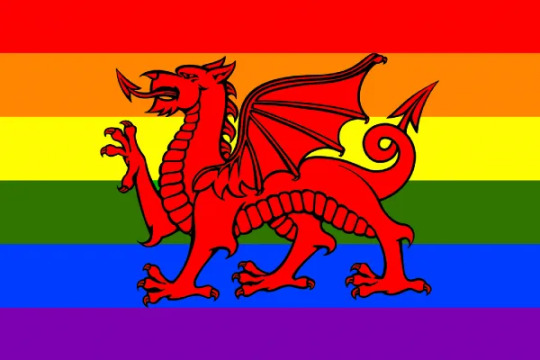
All the information on this post has come from Stonewall, who's page has more terms than what I'm sharing here. Please take a look if that interests you. Also, feel free to share any additions or corrections! <3
#cymraeg#dysgu cymraeg#welsh#cymru#wales#language#langblr#language learning#studyblr#vocabulary#vocab#vocab list#queer#queer representation#lgbtq#lgbtqia#pride#lesbian#gay#bisexual#transgender#pansexual
585 notes
·
View notes
Text
I was trying to figure out how dyke would be translated into Welsh as a borrowed word like cwiar (which is queer) and it would be spelt dîc
#dîc is pronounced how dyke is#just ironic that it looks kinda like dick#could also be spelt as dauc tho
10 notes
·
View notes
Photo

Spice jars set... Pprceline material... AIR TIGHT JARS cash on delivery 03165166676 #crockry_hut #no_shop_no_outlet #COD_ALL_OVER_PAKISTAN #Multan #original #Rawalpindi #Lahore #CODAllOverPakistan #spicerack https://www.instagram.com/p/CWiAR-JNXVx/?utm_medium=tumblr
#crockry_hut#no_shop_no_outlet#cod_all_over_pakistan#multan#original#rawalpindi#lahore#codalloverpakistan#spicerack
0 notes
Text
Happy international lesbian day ! The word for lesbian in Welsh is 'lesbiaidd'

#cymraeg#cwiar#welsh#hoyw#lhdt#lesbiaidd#lesbian#international lesbian day#lesbian day#sapphics#saffig
435 notes
·
View notes
Text
Bore da Cymblr! Do you know how to describe your sexuality in Welsh?
/
Bore da Cymblr! Ydych chi'n gwybod sut i ddisgrifio eich rhywioldeb yn Gymraeg?

Or write in the tags!
/
Neu sgwennu yn y tagiau!
#cymraeg#welsh#cwiar#lhdt#hoyw#lesbiaidd#deurywiol#panrywiol#hollrywiol#anrhywiol#anrhamantus#angyfunrhywiol#strêt#gê#heterorywiol
225 notes
·
View notes
Text
Today is International Asexuality Day - asexual in Welsh is 'anrhywiol' and was first used for sexuality in Welsh in 1986.

#international asexuality day#anrhywiol#anrhywioldeb#asexual#asexuality#cymraeg#cwiar#lhdt#cymru#welsh
767 notes
·
View notes
Text
On Cadi as the Welsh equivalent of Queer

(image: screenshot of the entry for Cadi in Geiriadur Prifysgol Cymru)
Some of you may already know this, but for those who don't, Cadi is a Welsh word which is analogous to the word Queer in English. I say analogous, since their meanings aren't quite a 1:1 match. But for shorthand, Welsh equivalent of Queer sums 90% of it up.
It has been suggested tentatively by some to use Cadi as the Welsh translation of Queer. I'm going to explore arguments for and against, but ultimately the choice to use/not use Cadi as a 1:1 with Queer is entirely up to you. Warning that this post is quite long, but I do hope you'll stick with it- please let me know what you think in the notes!
Without further ado, let's get into it:
Definition of Cadi:
Cadi is a term which has existed in Welsh since the 17th Century (roughly) and generally refers to effeminacy in men (real or perceived). Over time, the meaning of the term has expanded to refer to other (Queer) things as well. But the term itself largely has been applied to Queer men and queer masculinities through time.
The term itself derives from the girl's name Catrin and you will come across women who call themselves Cadi as a shortening of their name (like Liz from Elizabeth and so on). In this way, there is a strong point of comparison to be had with the English queer pejorative Nancy, which also derives from a girl's name.
Can Cadi be considered the Welsh equivalent of Queer?
So now to the real meat of the post. Can Cadi be considered the Welsh equivalent of Queer? The answer to that is, unsurprisingly, complicated.
As described above, Cadi is a term which has had strong associations with male effeminacy (real or perceived) and has close parallels to the English term Nancy, which is also nearly exclusively applied to Queer men and masculinities. What this presents is a quandary and I'll explain what I mean by that. But first, we need to outline the history of LGBTQIA+ terminology in general (in the West).
LGBTQIA+ Terminology and the inclination towards cis gay language:
This is a huge huge topic which I cannot possibly do justice to here alone, so I'd highly recommend reading up on these topics when you have time, but for the sake of brevity, here is a tldr on the history of LGBTQIA+ terminology (slightly UK-centric but similar events also happened in the US and Canada, as well as other parts of Europe).
Campaign for Homosexual Equality (CHE) is a British Lesbian and Gay rights organisation founded in the 1960s, during a time of great social and political change. The organisation's membership grew and grew well into the 70s before declining in the 80s. It was during this time that some lesbian members of the organisation left citing erasure of lesbian issues and misogyny in the movement.
CHE and similar gay and lesbian rights movements in this period had been inclined to centre gay men's issues in their activism, which understandably led to many lesbians feeling alienated. Some lesbians left in the late 70s and early 80s and began to form their own advocacy groups. This indirectly fed into a wider feminist upheaval at the time and led to the rise of lesbian feminism, which aimed to centre lesbian issues within feminism, but unfortunately (for complex historical reasons) did then contribute to the proliferation of rad\ical femi\nism within the Queer community, which then unfortunately contributed to the rise of tra\ns exclu\sionary rad\ical fem\inism.
Regardless of the unfortunate rise of transphobia within the lesbian feminist movement, the original catalyst for the formation of these groups was a sense of alienation from the rest of the Queer community because gay men's issues had been prioritised over lesbian issues, when both could have been tackled together, with each other. This alienation was echoed in the names of organisations and events- many early homosexual rights groups only had homosexual or gay in their group names. It took many years before advocacy groups started adding 'and lesbian' to their names and events.
(For further reading, I would suggest watching this video by Verilybitchie about the history of lesbian erasure in homosexual advocacy and how that led to (some) lesbian groups excluding bi and trans people in the same way they were excluded by gay men)
What does that history mean for Cadi?:
Because of a history of lesbian (and by extension, women's) exclusion from homosexual advocacy groups, is Cadi the best term to use as a catch-all given its strong associations with men's expressions of Queerness? (namely, that as a pejorative it is largely aimed at femininity in men and subsequent assumed homosexuality). It is important to consider if using Cadi as an equivalent of Queer would centre a (typically cis) gay experience/expression of Queerness and if that would alienate other members of the LGBTQIA+ community.
However, a counterpoint to this would be that there are variations of the term Cadi which do include other experiences of Queerness:
Cadi ffan (similar to just 'Cadi')- typically used to describe femininity in men and boys [N. Wales]
Cadi genod/ Cadi merched (similar to above) - effeminate man/boy [N. Wales]
Cadi bechgyn - Romping girl, tomboy [N. Wales]
Cati fachgen - (similar to above)- Romping girl, tomboy [S. Wales]
Cadi Haf - Male maypole dancer dressed as a girl
They are, however, somewhat limited for use in reclamation and have to be qualified by another noun to indicate diversion from the original term's meaning.
But when talking about the term Cadi, we often speak in the abstract- without the context in which the term is used. So here are a few extracts from texts which use the term Cadi (or variants). Since this is a mostly spoken slang term, it doesn't turn up in print often, but there are a few examples to draw on.
Examples of Cadi in texts:
Page 164- Cwm Eithin by Hugh Evans (1931):
"DAWNSIO HAF
Ceir darnodiad o'r ddefod hynafol dawnsio haf yn Y Gwyl- fedydd, 1823, tudal. 306, gan un a'i geilw ei hun “ Callestrwr,” fel yr arferid hi yn Callestr (Fflint, mae'n debyg). Ym mis Ebrill arferai o ddwsin i ugain o bobl ieuainc ymuno i baratoi ar gyfer y ddawns. Gwisgai'r dawnswyr eu crysau yn uchaf wedi eu haddurno ag ysnodennau a blodau. Cariai'r arweinydd fforch bren ar lun y llythyren Y. Gwnïid lliain o'r naill fraich i'r llall, ac addurnid y fforch ag amryw lestri arian, tebotiau, llwyau, cigweiniau, efc. Byddai gyda hwy grythor yn ei ddillad ei hun, “cadi” mewn gwisg merch, ac ynfytyn mewn gwisg ryfedd â phlu yn ei ben"
[emphasis mine]
This extract is the author's account of Dawnsio Haf- a Summer dance held on May Day and his investigations into it. At his time of writing (1931) the practice has died out, but later in this chapter he interviews an old woman from the Conwy Valley who participated in the dances as a child. Evans draws upon a source from 1823 for his description of Dawnsio Haf. In it, he mentions that 20 young dancers meet up for the dance wearing shirts decorated with ribbons and flowers. A leader carries a fork in the shape of the letter "Y"- between each point on the "Y" a cloth was strung with silverware dangling from it to make noise. With the 20 dancers would be a crwth-player (crythor), a Cadi in women's clothes and a fool with a feather on his cap and odd clothes.
This usage is quite archaic and refers to a folk dance- much like mumming or morris-dancing. There is however, a picture in the People's Collection Wales titled 'Cadi'r Big' taken by the prolific photographer John Tomas c. 1875, near Y Ro-wen:
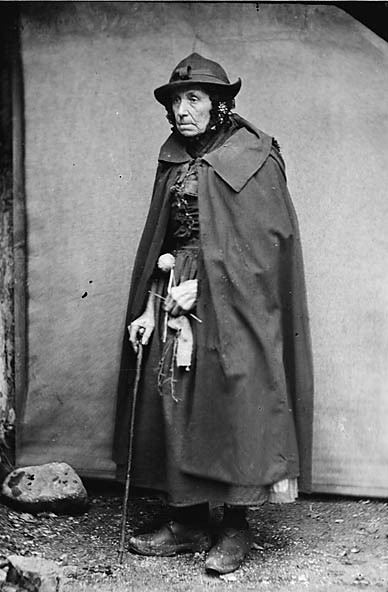
Which is very interesting as Cadi'r Big has dried flowers and ribbons attached to their clothes, much like in the description in Cwm Eithin. This is very likely a picture of a "Cadi" from a Dawnsio Haf.
Page 4- Y Ddraig Binc Issue 4 (1994):
Y Ddraig Binc was a Welsh-language Queer magazine published by CYLCH, a gay and lesbian rights organisation based in Aberystwyth. The term Cadi-ffan is included in an article about the commercialisation of Queer identity in the magazine's fourth edition.
"...Nawr te, medd wrtho’i hun, be’ gymera’ i’r mis hwn, copi o GQ ynte Arena neu ydw i, efallai, yn teimlo’n ddigon ifanc a trendi am Sky? Ond aros funud, beth yw hyn? Dau gylchgrawn steil newydd a gwynt digamsyniol cadi-ffan arnyn nhw?
Ydy, mae’r hyn a oedd y tu hwnt i ddychymyg wedi digwydd.
Mae grymoedd y farchnad rydd a chystadleuaeth wedi cyrraedd y byd
cyhoeddi hoyw - rhaid bod Lêdi T wrth ei bodd. Nawr fe gaiff llanc hoyw ddewis o ddeunydd darllen sgleiniog, llawn erthyglau a hysbysebion yn arbennig ar ei gyfer ef a’i rywioldeb. Hwrê! Fedr hynny ddim bod yn beth drwg. Neu a fedr o?..."
[emphasis mine]
This humorous article (dealing with an important topic, mind) pokes fun at the arrival of Queer commercialisation. The article opens by explaining that there's a ruckus in the gay world (and not two old queens getting into fisticuffs)- but that this ruckus is taking place at WHSmith (UK stationery shop and newsagents)- apparent winner of this year's most vulgar uniform award. The author goes on to describe a hypothetical situation in which a gay man walks into a WHSmith to buy a magazine. He wonders whether to get a copy of GQ or Arena (men's style magazines- remember this was published in Section 28 Era so explicitly gay magazines were not common) or is he trendy enough to read Sky? (film and tv magazine). But wait- what's this? Two new style magazines with a whiff of Cadi-ffan about them? The author explains that yes, the unimaginable has happened. The forces of the free market and competition have reached the world of gay publishing.
Now a gay youth has the choice of glossy reading material, full of articles and advertisements especially for him and his sexuality. Hooray! That can't be a bad thing. Or can it? Writes the author. The article is very witty and I recommend a read (find a pdf copy here). But the usage of Cadi-ffan here is very much in a reclaimed sense. Though it must be noted that the story is told through a stereotypical cis gay lens.
Conclusions:
As I said at the start of this post, you are free to claim or not claim Cadi as you wish. However, as awareness of Welsh LGBTQIA+ terminology increases, I wanted to raise important questions and start a conversation about the words we have, what we want them to be and how they have been used against us. I hope in any case that this post has been interesting to you. If it has, please reblog this or add any comments/thoughts in the notes, tags or in my asks.
Beth yw eich barn chi? I'd love to hear other's thoughts on this and start a conversation about it! Diolch am ddarllen
#cymraeg#cwiar#cadi#cadi ffan#Welsh#Gymraeg#yr iaith gymraeg#term reclaiming#hoyw#lhdt#deurywiol#lesbiaidd#cymru#long post
308 notes
·
View notes
Text
Gilbert Baker pride flag stripe meanings yn Gymraeg

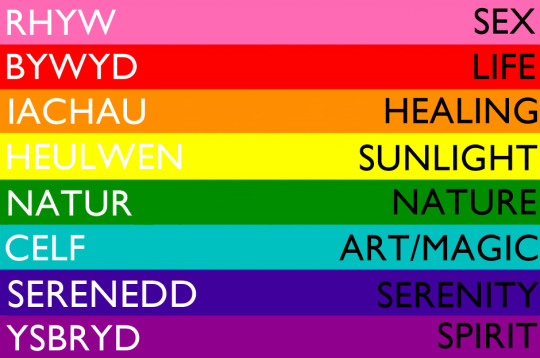

Made some edits of the Gilbert Baker pride flag with the meanings in Welsh. Free to use with credit/link to me.
#cymraeg#cwiar#welsh#hoyw#deurywiol#trawsryweddol#lesbiaidd#cymru#lhdt#gilbert baker flag#gymraeg#uk trans#uk#Wales
334 notes
·
View notes
Text
Llyfr Enfys x Hanes LHDT+ Cymru

Helô pawb! I am here today with to announce that I've been working with Hanes LHDT+ Cymru to publish the second chapter of my undergraduate dissertation "What drove the development of Welsh-language LGBTQIA+ terminology 1972-2022” for free on their blog!
Find the chapter here: https://lgbtqcymru.swansea.ac.uk/2023/10/03/the-post-1957-shift-in-lgbtqia-language-in-wales/
Some of you may also remember that I have worked with Hanes LHDT+ Cymru before and written some blogs for them. You can find them here:
Term Anniversaries- Vital Landmarks for Welsh LGBTQIA+ History (April 2023)
A brief history of Lesbian, Bisexual, Trans, Intersex and Other terminology in Welsh dictionaries (Nov 2022)
Rhagenwau Rhyfedd- The Wonderful World of Weird Welsh Pronouns (Sept 2022)
Queer Ancestry- A look into the familial lives of some of Wales’ Queer historical figures (July 2022)
Papurau Pinc | Pink Papers: 18th-21st Century Welsh language newspaper reporting on Queer folk (June 2022)
The Case of the 450 year-old Word: A Queer Welsh slur throughout the centuries (June 2022)
#cymraeg#cwiar#welsh#hoyw#lhdt#llyfr enfys project#prosiect llyfr enfys#hanes lhdt cymru#cymru#trawsryweddol#deurywiol#lesbiaidd
122 notes
·
View notes
Text
So I made Pride versions of the flags of the 13 Historic Counties of Wales:

This is the map of Wales with each county flag edited with pride colours! The palette I used was the final Gilbert Baker pride flag which he created before he died. Just for fun and these are free to use with credit.
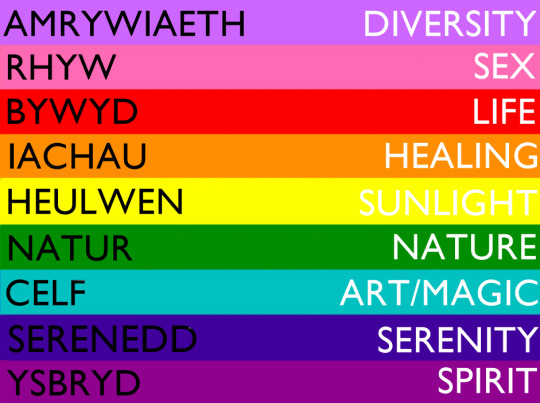
(Note: several flags are proposed flags, since some counties have not registered official flags yet)
Column 1: Glamorganshire, Cardiganshire, Merionethshire, Montgomeryshire
Column 2: Monmouthshire, Caernarfonshire, Pembrokeshire, Carmarthenshire, Radnorshire
Column 3: Ynys Môn, Flintshire, Brecknockshire, Denbighshire

#eyestrain#lukes originals#bright colours#bright colors#cymraeg#welsh#cwiar#cymru#gilbert baker flag#gilbert baker#lavender stripe#flag edit#county flags#flags of Wales#Wales
165 notes
·
View notes
Text
Welsh Gender Neutral Family Terms
We've come up with some gender neutral Welsh family terms in the LGBTQIA+ Welsh discord I run (dm for link) lately and so far people seem to like the terms. So, this is an introduction to some of the terms we've come up with so far.
I plan to make polls eventually with these terms and any other suggestions you might have and run a little tournament to see which terms are favoured most by Welsh speaking LGBTQIA+ people.
Without further ado, here are the terms:
(f. = feminine grammatical gender, m. = masculine grammatical gender)
Chwaed(ion) f. - Sibling(s)
[‘chwaer’ (sister) + ‘brawd’ (brother). Rhymes with ‘gwaed’ (blood), reminiscent of family ties]
Chwaerydd m. - Sibling
['chwaer' + '-ydd' (masculine suffix) ]
Chwaed fy mam / fy nhad - Aunt/Uncle (Literally, my mother’s/father’s sibling)
[Literal translation (my mother’s / father’s sibling) ]
Naith f. - Niece/Nephew
[‘nith’ (niece) + ‘nai’ (nephew) ]
Dain (Deiniau) f. - Grandparent(s)
[‘taid’ (grandfather)+ t > d + ‘nain’ (grandmother) ]
Nam-gu f.- (Grandparent)
['fy nhad-cu' + 'fy mam-gu']
Of course, these are only suggestions. So far, chwaed has been very popular and dain has been preferred over nam-gu because it's less South Walian. But I'm interested to hear what you think or hear if you have any suggestions of your own!
Please share this post so we can get a larger sample size. Diolch!
NB:
These terms have come from multiple users, so bear that in mind with feedback. I can pass on suggestions to the users who coined them.
Grammatical gender is unavoidable in Welsh, but grammatical gender does not necessarily equal gender gender. E.g. the German word for girl 'maedchen' is grammatically neutral. In addition to this, certain suffixes in Welsh are gendered, which affects how words behave in certain sentences.
#Welsh#gender neutral#neutral terms#nonbinary#anneuaidd#LHDT#cwiar#langblr#Welsh terms#Cymraeg#Gymraeg#hoyw#trawsryweddol#deurywiol#lesbiaidd#lhdt#cymru
341 notes
·
View notes
Text
Sequel to yesterday's poll!:
Bore da again Cymblr! Do you know how to describe your gender in Welsh?
/
Bore da eto Cymblr! Ydych chi'n gwybod sut i ddisgrifio eich rhywedd yn Gymraeg?

Or write in the tags!
/
Neu sgwennu yn y tagiau!
#cymraeg#welsh#cwiar#trawsryweddol#cymblr#lhdt#anneuaidd#rhyweddgwiar#rhyweddhylifol#trawswrywaidd#trawsbenywaidd
55 notes
·
View notes
Text
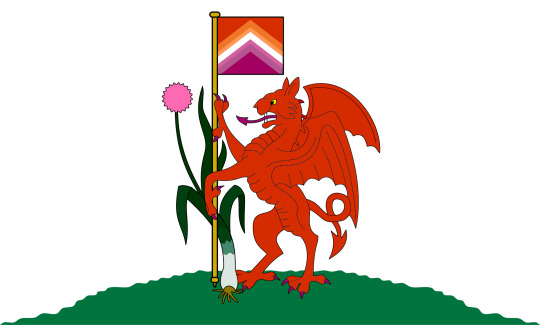
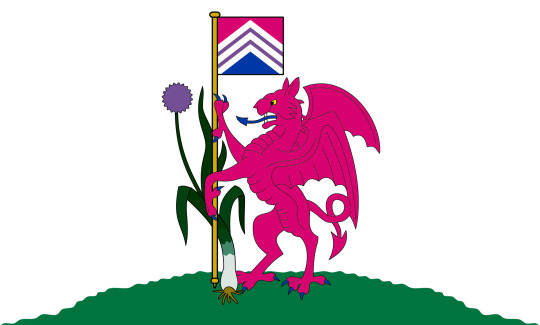

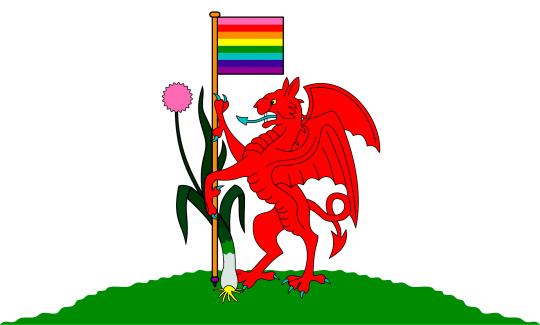
A collection of Cardiff flag/Pride flag mashups!
152 notes
·
View notes